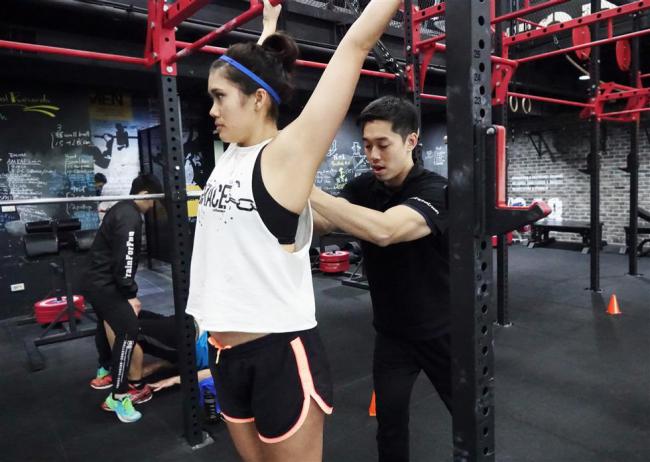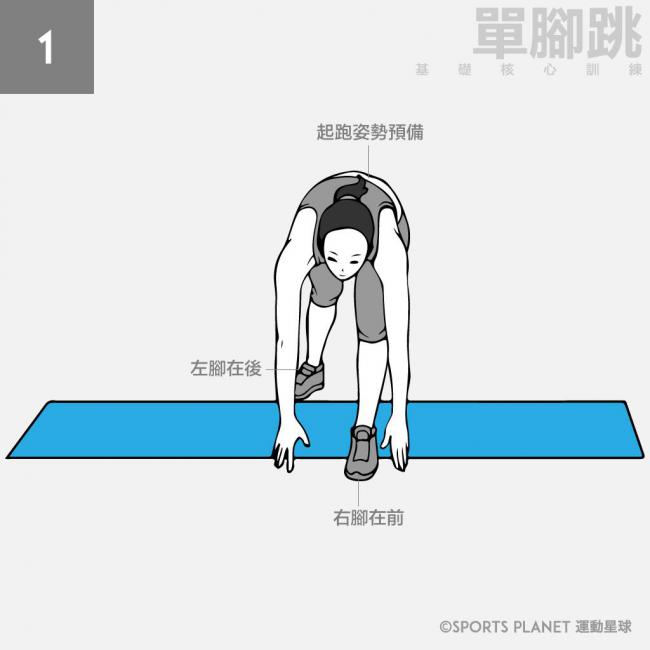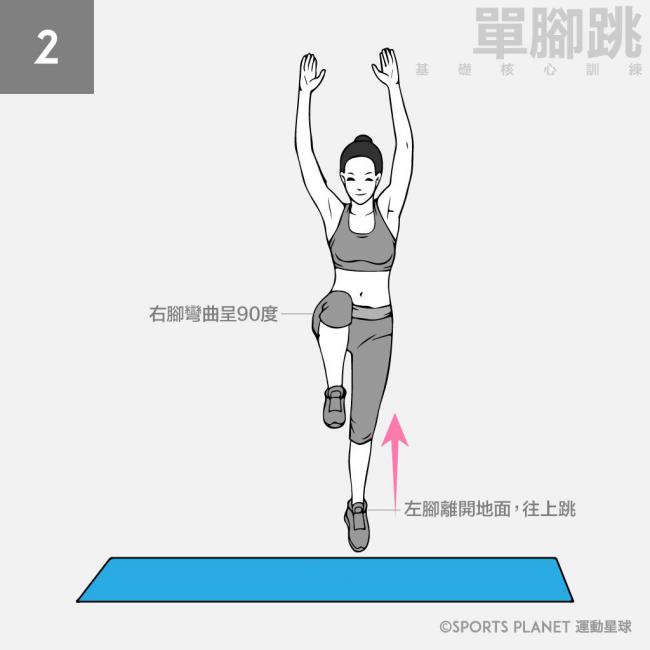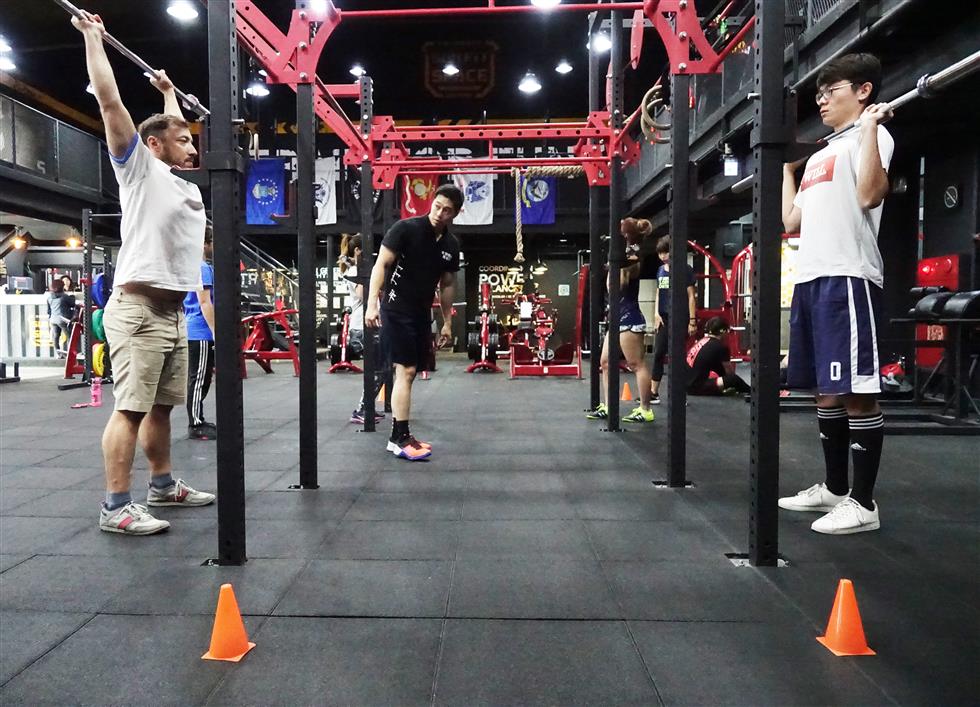
運動星球
太陽體能運動空間:運動不無聊 美軍訓練系統Crossfit在台南
2016-08-18
南臺灣第一家以Crossfit為訓練方式的健身中心,在台南目前有兩家,分別是海安路和永康館的「太陽體能運動空間」,創辦理念是對於美式的Crossfit訓練方式特別心儀,認為這是有效、不依賴固定型機器、符合身體自然律動、訓練全身協調性最好的方式。Crossfit透過結合心肺耐力項目,諸如中短距離衝刺,長距離划船、跑步,再加上舉重專項、體操專項等元素,讓Crossfit的訓練者可以提高心肺耐力、肌耐力、最大肌力、柔軟度等,非常適合單車、游泳和體操愛好者。

南臺灣第一家以Crossfit為訓練方式的健身中心太陽體能運動空間
黑色紐約工業風,塑造輕鬆歡樂的運動氣氛
距離市區不遠的永康館,有別於海安館的空間規劃,外觀以黑色紐約工業風塑造出運動輕鬆歡樂的氣氛,大門處與接待處分別以一個貨櫃切割,而場館內部設計也強烈表現出創辦人的獨特風格。健身空間主要有兩層樓,一樓區規畫為機械式重訓區、有氧區、TRX訓練區、一對一私人教練區重訓區、舉重區和兒童遊戲間。劉鍾陽執行長認為,健身的進階應該要加強自由重量訓練,特別是人體自然的動作,因此固定式舉重區分別固定六塊木板,他說:「一般健身房不鼓勵摔槓,但我們的可摔槓式場地,木質地板讓運動無後顧之憂」,舉重區不分男女,以團體課教學方式,搭配木箱的彈跳,讓看似枯燥的舉重運動增加更多層次。

黑色紐約工業風
療癒草皮,發揚訓練技巧
二樓則增加相同於羽球場的PU跑道供短程跑步,空氣腳踏車和跑步機吸引習慣一般健身房的客人,Sun說:「風的阻力很適合做間歇的訓練」;而划船機則是國際Crossfit比賽指定專用。內部設備多以紅黑為色調,幾乎是百分之百選用Crossfit指定器材,除了徹底發揚該訓練技巧外,也鼓勵教練參加比賽。Crossfit訓練時不使用固定式器械,訓練者必須仰賴自己的身體,利用組合的動作讓學員自然地培養爆發力、速度、協調性、敏捷、平衡感、動作精準度。草皮區讓人感到相當療癒,在上面可以做滾筒、伸展或是雪橇運動。

療癒專用草皮,可做滾筒或雪橇等運動
紀錄訓練過程以玆鼓勵
「太陽體能運動空間」吸引許多專業人士,如舞者、中高齡醫生和選手們。27歲的年輕女孩白白,曾經是統一獅的啦啦隊舞者,到這運動約有半年,她說:「我來這邊主要是做重量訓練」過去是田徑隊的她偶爾也喜歡上一對一的拳擊課程。21歲男生PAC背景是街舞,為了加強自己的協調性特別來這訓練;女生教練Becky目前29歲,到此工作的夢想是希望可以傳遞正確的健康理念給學員。看似需要鋼鐵意志的Crossfit training,其實充滿趣味,教練會將每一個人的狀況以粉筆記錄在黑板牆上,密密麻麻的筆記包括學員姓名、課程內容、燃燒卡路里等,都可以被用來激勵學員運動。

以粉筆記錄個人狀況激勵學員運動
提升10種身體能力的方式
教練平均年齡低於三十歲,強調精緻化客製服務,回想起創業的動機,是因為坊間找不到自己喜歡的訓練方式,劉鍾陽原本以為可以嘗試性投入試探市場,沒想到一路前進無法回頭,大量投資專業的設備,也吸引更多年輕人投入健身產業,因為時常接觸最新趨勢,不自覺主動進修,提供最好的建議給運動者。相信運動不應該感到無聊,藉由簡單的設備便可以設計出千變萬化的課程,達到每一個人健身的目標。鼓勵大家吃得健康,CrossFit的核心原則是全面提升10種身體能力,不止單純地追求外型線條,也不強調小範圍的肌肉訓練,而是將田徑、體操與舉重運動中的基礎動作,如推、拉、提、舉、蹲等融入日常生活中,更加適合女性、小孩、中老年人等族群。

太陽體能運動空間教練群
一對一教練課程
- 運動員肌力與體能訓練
- 體重控制(增肌減脂)
- 曲線雕塑
- 強化肌肉線條
- 復健後運動訓練
- 特殊族群訓練

團體運動課程
- CROSSFIT團體課程
- 舉重團體課程
- 兒童體適能課程
- 瑜珈課程
- 壺鈴團體課程
- 槓鈴肌力團體課程


兒童遊戲室
太陽體能運動空間永康店
add 台南市永康區中華路249號
time 週一~週五:6:30~00:00、週六~週日:08:00~00:00
price 採不綁約以分鐘計時(以每分鐘1元計費)、年費方式收費(一對一教練額外計費)
FB 太陽體能空間永康店
time 週一~週五:6:30~00:00、週六~週日:08:00~00:00
price 採不綁約以分鐘計時(以每分鐘1元計費)、年費方式收費(一對一教練額外計費)
FB 太陽體能空間永康店
撰文/佳佳玖
攝影/侯成育


運動星球
單腳跳 SINGLE FOOT LUNGE JUMPS
2016-06-01
單腳跳 (Single Foot Lunge Jumps)是一個下半身的有氧訓練。主要訓練腿部的力量和心肺耐力,除了能增加和新的平衡外,平時在做其他運動前,用於暖身效果也佳。
單腳跳
鍛鍊肌肉群:下半身
動作難度:★

STEP 1 準備動作
右腳在前,左腳在後,呈起跑姿勢預備。

STEP 2 左腳往上跳
右腳彎曲呈90度,左腳離開地面,往上跳。

STEP 3 右腳往上跳
左腳彎曲呈90度,右腳離開地面,往上跳,左右輪替,做1分鐘。



